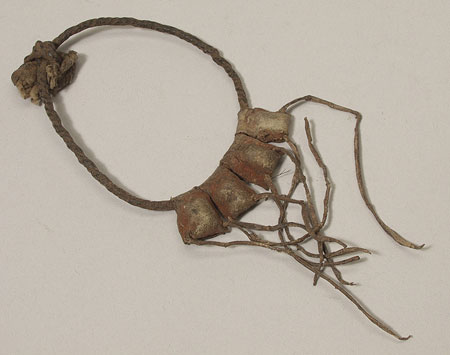Accession Number:
1903.16.129
Country:
Sudan
Region:
[Southern Sudan] Wahda Lake No
Cultural Group:
Nuer
Date Made:
By 1903
Materials:
Animal Hide Skin
Process:
Twisted , Knotted , Strung , Stitched
Dimensions:
Arm band L = 70, W = 62, diam = 2.4 mm; capsule L = 15.5, W = 10.6, th = 7.1 mm; hide tassels L = 40 to 84 mm [RTS 27/8/2004].
Weight:
5.8 g
Field Collector:
Donald Gunn
PRM Source:
Donald Gunn
Acquired:
Donated 1903
Collected Date:
By 1903
Description:
Arm ornament consisting of a short length of light brown twisted hide cord (Pantone 7508C), bent into a loop and with the ends knotted together.
This has been strung with four rectangular yellow to yellowish brown hide capsules (Pantone 7506C).
Each has been made from a rectangular strip, doubled over at the base to form a small pocket that is fastened together near the top with a single, long hide stitch, visible on the outside face.
The other end of this strip has been folded over the cord and down the back of the pocket, where it is secured with additional stitches.
The inside of each pocket is not visible, but they have convex bulges at the front, suggesting that they act as containers, probably for a charm such as a phrase from the Koran.
A long thin strip of hide hangs down from the bottom corners of each capsule as tassels.
The armlet is complete, with the surface of each capsule being partially smeared with red ochre.
It has a weight of 5.8 grams, with the arm band measuring 70 by 62 mm across, and having a diameter of 2.4 mm.
A typical capsule is 15.5 mm long, 10.6 mm wide and 7.1 mm thick, while the hanging hide strips range from 40 to 84 mm in length.
Collected by Donald Gunn from Lake No in the Southern Sudan and presented to the Pitt Rivers Museum in 1903. Gunn appears to have collected Shilluk material from the ‘White Nile’, ‘Upper Nile’, Kodok and Bor, Nuer material from around Lake No, Dinka material from the ‘White Nile’ and Arab material from Omdurman.
This armlet probably had an amuletic use; for similar items designed to be worn around the neck, see 1903.16.126 (Nuer), and 1903.16.122-123 (Dinka).
The wearing of written charms, sewn up into leather packets, is an Arab practice, found in Egypt and the northern Sudan, and this example probably represents its spread amongst Nilotic Sudanese. Schweinfurth, for example, recorded that: "The Nubians and true Arabs ... often wear round their neck and arms a number of ornamental leather sheaths, which contain passages from the Koran; on being asked what is inside they reply, 'it is the name of god'. Such amulets are even bound round the necks of horses and valuable asses” (G. Schweinfurth, 1873, In the Heart of Africa vol. 1, p. 142); Petrie also reported the practice amongst the Egyptian fellahim: “"Many - perhaps most - of the people wear charms, written on paper, and sewn up in leather; they are worn around the neck, on the purse or pouch, or on the top of the cap. Cattle are also sometimes protected by them" (W.M.F. Petrie, 1892, Ten Years Digging in Egypt , p. 169).
Currently on display in the Court, case 29A.
Rachael Sparks 18/9/2005.
Collected by Donald Gunn from Lake No in the Southern Sudan and presented to the Pitt Rivers Museum in 1903. Gunn appears to have collected Shilluk material from the ‘White Nile’, ‘Upper Nile’, Kodok and Bor, Nuer material from around Lake No, Dinka material from the ‘White Nile’ and Arab material from Omdurman.
This armlet probably had an amuletic use; for similar items designed to be worn around the neck, see 1903.16.126 (Nuer), and 1903.16.122-123 (Dinka).
The wearing of written charms, sewn up into leather packets, is an Arab practice, found in Egypt and the northern Sudan, and this example probably represents its spread amongst Nilotic Sudanese. Schweinfurth, for example, recorded that: "The Nubians and true Arabs ... often wear round their neck and arms a number of ornamental leather sheaths, which contain passages from the Koran; on being asked what is inside they reply, 'it is the name of god'. Such amulets are even bound round the necks of horses and valuable asses” (G. Schweinfurth, 1873, In the Heart of Africa vol. 1, p. 142); Petrie also reported the practice amongst the Egyptian fellahim: “"Many - perhaps most - of the people wear charms, written on paper, and sewn up in leather; they are worn around the neck, on the purse or pouch, or on the top of the cap. Cattle are also sometimes protected by them" (W.M.F. Petrie, 1892, Ten Years Digging in Egypt , p. 169).
Currently on display in the Court, case 29A.
Rachael Sparks 18/9/2005.
Primary Documentation:
Accession Book Entry
[III, p.
110] - 1903 [pencil insert] 16 [end insert]
DR
D.
GUNN
Esq., M.B.
40 Dover Street, London, W.
June.
[...] [p.
114, pencil insert] 129 [end insert] - Nuer armlet with hide charm capsules, ib[idem] [LAKE NO, UPPER NILE].
Card Catalogue Entry - There is no further information on the tribes catalogue card [RTS 23/7/2004].
Old Pitt Rivers Museum label - Charm Armlet. NUER, LAKE NO, UPPER NILE. Pre. by Dr. Gunn, 1903 [circular metal-edged tag, tied to object; RTS 27/8/2004].
Card Catalogue Entry - There is no further information on the tribes catalogue card [RTS 23/7/2004].
Old Pitt Rivers Museum label - Charm Armlet. NUER, LAKE NO, UPPER NILE. Pre. by Dr. Gunn, 1903 [circular metal-edged tag, tied to object; RTS 27/8/2004].




